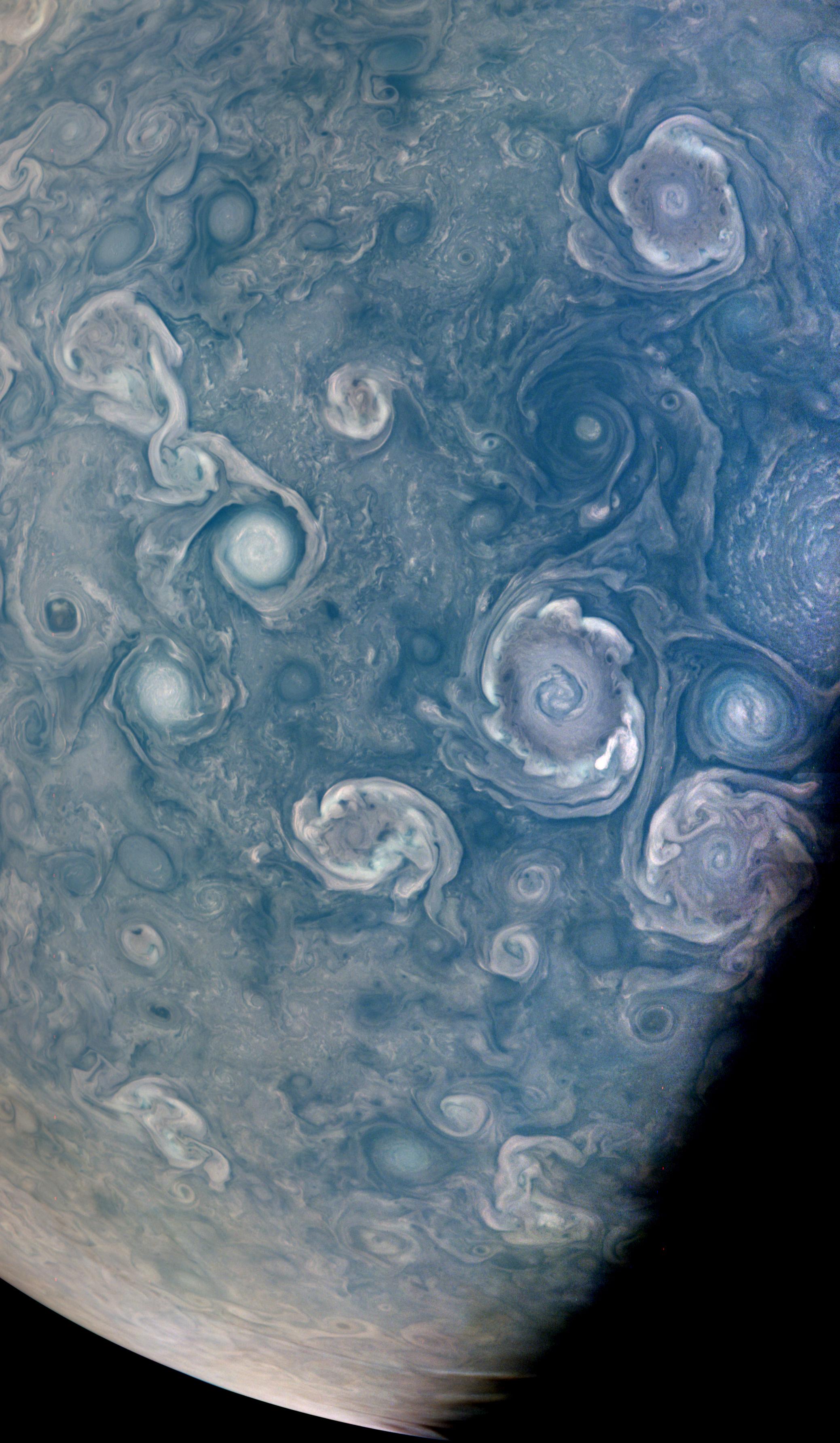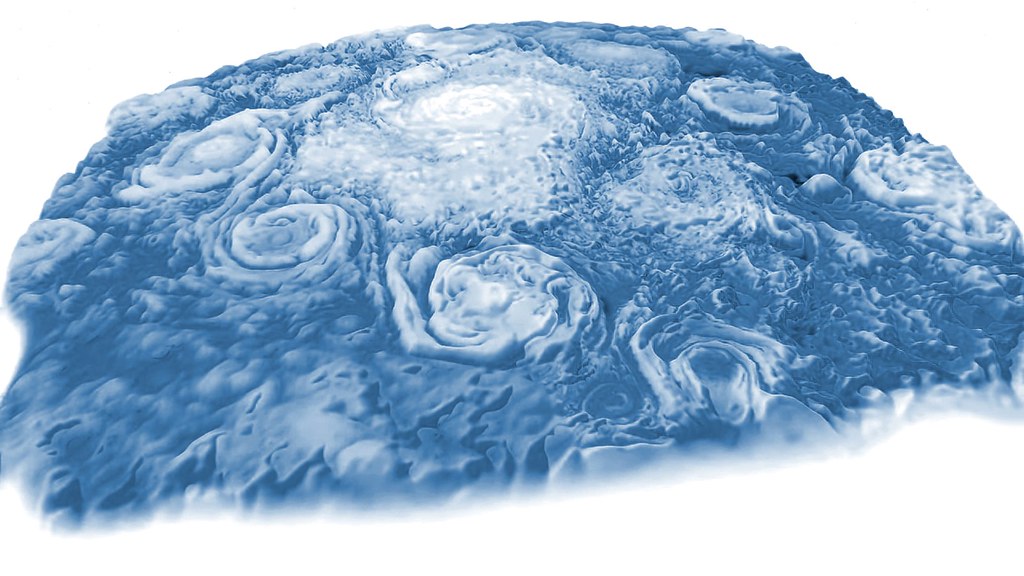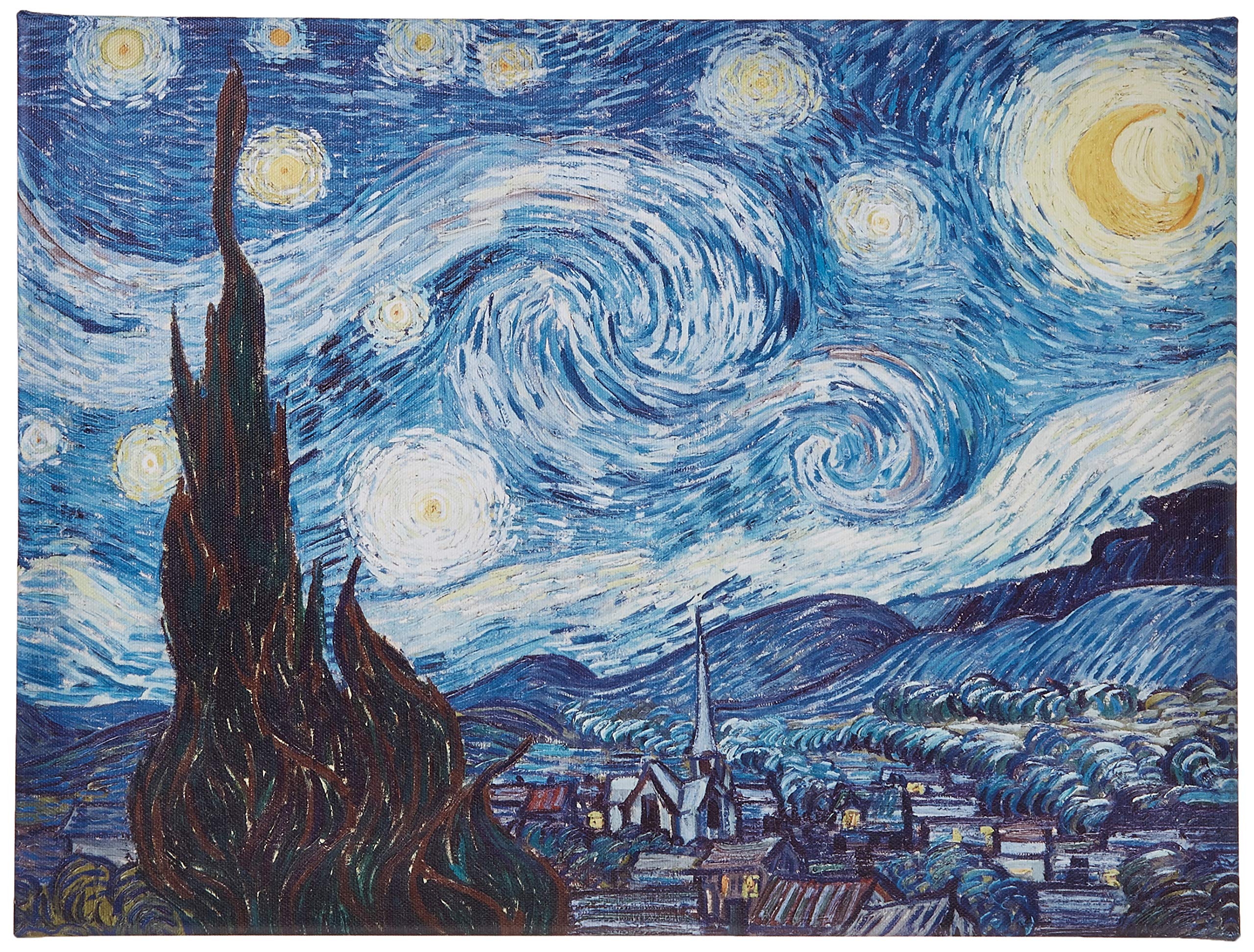It looks like you're using an Ad Blocker.
Please white-list or disable AboveTopSecret.com in your ad-blocking tool.
Thank you.
Some features of ATS will be disabled while you continue to use an ad-blocker.
20
share:
This latest image from Juno shows a number of vortices raging around the planet's North pole , NASA say the vortices can extend some 30 miles deep and
span hundreds of miles across.

Pretty sure my uncle had some wallpaper just like that in the 70s.

Figuring out how they form is key to understanding Jupiter's atmosphere, as well as the fluid dynamics and cloud chemistry that create the planet's other atmospheric features. Scientists are particularly interested in the vortices' varying shapes, sizes, and colors. For example, cyclones, which spin counter-clockwise in the northern hemisphere and clockwise in the southern, and anti-cyclones, which rotate clockwise in the northern hemisphere and counter-clockwise in the southern hemisphere, exhibit very different colors and shapes.
photojournal.jpl.nasa.gov...
Pretty sure my uncle had some wallpaper just like that in the 70s.
edit on 29-7-2022 by gortex because: (no reason given)
They need to probe that beautiful thing, I am trembling to know what lies deep inside.
That sounded strange.. but dammit can we please pepper that thing with thick shielded probes already.
I heard rumors of a solid core, acid rain and diamonds.
That sounded strange.. but dammit can we please pepper that thing with thick shielded probes already.
I heard rumors of a solid core, acid rain and diamonds.
I just love your threads Gortex and really appreciate your perseverance to bring us information outside of our tiny circle of life.
Very beautiful scene but I'm sure like many things, beautiful on the outside and really dangerous on the inside.
Very beautiful scene but I'm sure like many things, beautiful on the outside and really dangerous on the inside.
a reply to: StoutBroux
In the 90s scientists worked out that wind speeds in vortices on Jupiter are around 900 mph , so yeah that would take more than the roof off your house.
Better outside than in.
Very beautiful scene but I'm sure like many things, beautiful on the outside and really dangerous on the inside.
In the 90s scientists worked out that wind speeds in vortices on Jupiter are around 900 mph , so yeah that would take more than the roof off your house.
Better outside than in.
a reply to: gortex
That storm that looks like a skill saw blade is very cool...
I wish they had that one storm (center - right) more in the frame. Looks pretty cyclic in form... If the right side looks like the left side... It almost looks like a tunnel.
Those storms almost look like something is harvesting gas from the surface of the planet... A big vacuum or something... lol
That storm that looks like a skill saw blade is very cool...
I wish they had that one storm (center - right) more in the frame. Looks pretty cyclic in form... If the right side looks like the left side... It almost looks like a tunnel.
Those storms almost look like something is harvesting gas from the surface of the planet... A big vacuum or something... lol
a reply to: ByteChanger
Agreed , don't know whether it's blown itself out or it's a different type of storm , it definitely looks more diffuse.
I wish they had that one storm (center - right) more in the frame.
Agreed , don't know whether it's blown itself out or it's a different type of storm , it definitely looks more diffuse.
edit on 29-7-2022 by gortex because: Derp
originally posted by: Spacespider
They need to probe that beautiful thing, I am trembling to know what lies deep inside.
That sounded strange.. but dammit can we please pepper that thing with thick shielded probes already.
I heard rumors of a solid core, acid rain and diamonds.
Diamonds?
Lucy in the sky?
or
Lucy in disguise? (with glasses)
The storms are formed as nature's way to vent the heat from the planet's surface, just as they are formed on earth's surface to vent heat from the
planet's surface. Heat up the earth's surface a little more and it is gonna be no picnic that is for sure.
We are already seeing increased storm intensity and size because of the warming of earth's surface. I wonder if we are going to get to a point where this prophecy is literally going to come true:
“On the earth anguish of nations not knowing the way out because of the roaring of the sea and its agitation."-Luke 21:25.
Good pictures. Have you seen the new picture of Jupiter from the JWST? Quite a beauty. Even the ring of Jupiter is visible.


We are already seeing increased storm intensity and size because of the warming of earth's surface. I wonder if we are going to get to a point where this prophecy is literally going to come true:
“On the earth anguish of nations not knowing the way out because of the roaring of the sea and its agitation."-Luke 21:25.
Good pictures. Have you seen the new picture of Jupiter from the JWST? Quite a beauty. Even the ring of Jupiter is visible.


originally posted by: Spacespider
a reply to: randomuser
omg.. that picture is just perfect. Is that new ?
Pretty new.
originally posted by: Lazarus Short
originally posted by: Spacespider
They need to probe that beautiful thing, I am trembling to know what lies deep inside.
That sounded strange.. but dammit can we please pepper that thing with thick shielded probes already.
I heard rumors of a solid core, acid rain and diamonds.
Diamonds?
Lucy in the sky?
or
Lucy in disguise? (with glasses)
Yes please
a reply to: Spacespider
They were released after the main images were released by the Webb team on the 12th as a bonus release.
They were released after the main images were released by the Webb team on the 12th as a bonus release.
a reply to: Dalamax
Yes , it's Europa.
Yes , it's Europa.
Clearly visible at left is Europa, a moon with a probable ocean below its thick icy crust, and the target of NASA’s forthcoming Europa Clipper mission. What’s more, Europa’s shadow can be seen to the left of the Great Red Spot. Other visible moons in these images include Thebe and Metis.
blogs.nasa.gov...
a reply to: CthulhuMythos
Reminds me of Van Gogh
That Starry night was the Pleiades
OP probably meant this one.
The Langlois Bridge at Arles is the subject of four oil paintings, one watercolor and four drawings by Vincent van Gogh. The works, made in 1888 when Van Gogh lived in Arles, in southern France, represent a melding of formal and creative.
Reminds me of Van Gogh
That Starry night was the Pleiades
OP probably meant this one.
The Langlois Bridge at Arles is the subject of four oil paintings, one watercolor and four drawings by Vincent van Gogh. The works, made in 1888 when Van Gogh lived in Arles, in southern France, represent a melding of formal and creative.
Great post gortex. BTW, that's Jupiter's hydrogen atmosphere we're looking down into, that's why it's blue.
A few years back they released a 3D visualisation of similar storms, taken in infrared: www.youtube.com...
So I took a screenshot and adjusted the colours to approximate what it would look like to our eyes:

A few years back they released a 3D visualisation of similar storms, taken in infrared: www.youtube.com...
So I took a screenshot and adjusted the colours to approximate what it would look like to our eyes:

new topics
-
Biden to award Presidential Citizens Medal to Liz Cheney and Bennie Thompson
US Political Madness: 14 minutes ago -
Just learned a really helpful trick for internet searches
Computer Help: 5 hours ago -
Not off to a good start
General Chit Chat: 7 hours ago
top topics
-
If they can see...they can read!!
Rant: 14 hours ago, 7 flags -
Not off to a good start
General Chit Chat: 7 hours ago, 5 flags -
Just learned a really helpful trick for internet searches
Computer Help: 5 hours ago, 4 flags -
Biden to award Presidential Citizens Medal to Liz Cheney and Bennie Thompson
US Political Madness: 14 minutes ago, 1 flags
active topics
-
If they can see...they can read!!
Rant • 21 • : cocnutcrab883 -
Biden to award Presidential Citizens Medal to Liz Cheney and Bennie Thompson
US Political Madness • 1 • : Athetos -
The C.D.C. Says There Was NO INFLUENZA Worth Reporting for the 2020-2021 Flu Season.
Diseases and Pandemics • 93 • : SteamyAmerican -
Vehicle Strikes people in New Orleans
Mainstream News • 265 • : starvosan -
The Hand that Rocks the Cradle - Labour Plans “diversities of our society” Curriculum Change
Regional Politics • 18 • : onestonemonkey -
Not off to a good start
General Chit Chat • 14 • : visitedbythem -
Maybe they didn't get away with it: The Lincoln-Kennedy assassination parallels. 7 sentences long.
History • 12 • : Solvedit -
Just learned a really helpful trick for internet searches
Computer Help • 7 • : Cvastar -
Simulation theory and have we reset before like a game?
Conspiracies in Religions • 42 • : crayzeed -
Post A Funny (T&C Friendly) Pic Part IV: The LOL awakens!
General Chit Chat • 7978 • : underpass61
20

